Introduction: The $22.3 Trillion Communication Gap
Picture this: You’re at a family dinner, and your mother asks, “So what exactly does your AI company do?” You launch into an explanation about neural networks, machine learning algorithms, and data pipelines. Five minutes later, her eyes have glazed over, and she’s reaching for more wine. This scenario highlights the challenge of explaining AI to non-technical audiences.
Sound familiar? You’re not alone. Gartner research reveals that a top inhibitor to agentic AI adoption is a lack of customer trust, and that trust gap often starts with communication.
Before you dive deeper into this challenge, you might want to assess where your organization currently stands. Our AI Readiness Assessment can help you understand your starting point, while the AI Implementation Roadmap Builder can guide your journey forward.
Here’s the harsh reality: More than half of generative AI budgets are devoted to sales and marketing tools, yet MIT found the biggest ROI in back-office automation. Why? Because businesses are struggling to communicate AI’s real value to the people who matter most—their customers.
The stakes couldn’t be higher. IDC predicts investments in AI solutions and services are projected to yield a global cumulative impact of $22.3 trillion by 2030 representing approximately 3.7% of the global gross domestic product (GDP). But here’s the kicker: Recent reports from 2025 paint a sobering but predictable picture — a staggering 95% of AI initiatives are failing to deliver their expected financial returns, according to research from MIT.
The difference between the 5% that succeed and the 95% that fail? It often comes down to one simple thing: the ability to explain what you do in a way that builds trust, drives adoption, and creates genuine understanding.
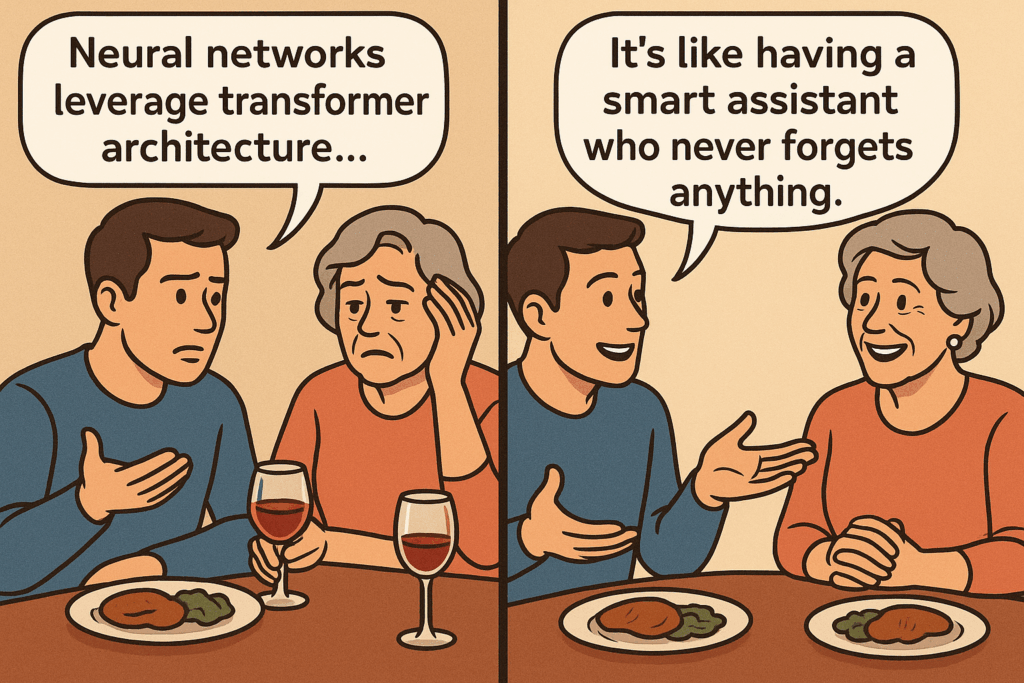
Part 1: The Mother Test – Your Ultimate Communication Benchmark
Why Your Mother is Your Best Focus Group
Your mother represents the ultimate non-technical audience. She’s intelligent, curious, and genuinely wants to understand what you do—but she doesn’t speak tech. If you can explain your AI business to her in a way that makes her eyes light up rather than glaze over, you’ve cracked the code.
Making complex AI technologies understandable for non-technical audiences is not just beneficial – it’s essential for fostering trust and engagement. When customers grasp how your AI works and what value it brings, they’re far more likely to adopt and champion your solution. This is key to explaining AI to non-technical audiences.
The 5-Second Rule
Here’s a brutal truth: You have about 5 seconds to capture someone’s interest before they mentally check out. That’s why the “elevator pitch” has evolved into what I call the “escalator pitch”—you need to hook them before they reach the next floor.
🎯 Ready to Master AI Communication?
Get our complete AI Communication Toolkit FREE – including 13 assessment tools that help you:
- Calculate your AI ROI potential
- Build your perfect AI tech stack
- Create a customized implementation roadmap
- Compare vendors side-by-side
- And much more…
→ Access All Free AI Assessment Tools Now
Join 10,000+ business leaders who are successfully explaining and implementing AI
Part 2: The Power of the Right Metaphor (Choose Wisely)
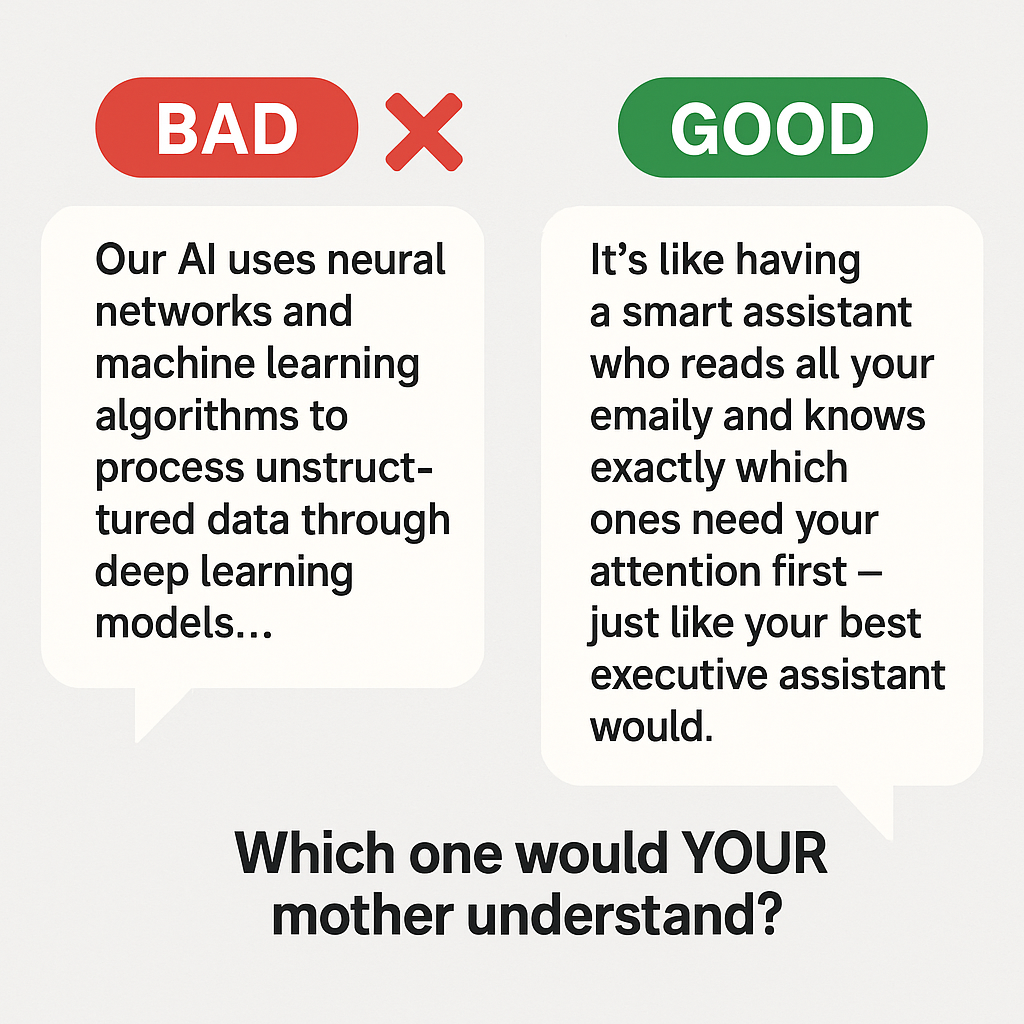
The Recipe Metaphor That Actually Works
You might compare a machine learning algorithm to a recipe – just as a recipe requires specific ingredients mixed in a certain way to create a dish, an algorithm needs data input in specific ways to produce results.
But here’s where most people stop. Don’t just use the metaphor—extend it:
- Training data = Your ingredients (and yes, quality matters—you can’t make a gourmet meal with expired ingredients)
- The algorithm = Your cooking method (are you baking, frying, or slow-cooking?)
- Model parameters = Your seasoning adjustments (too much salt ruins everything)
- The output = Your finished dish (hopefully Michelin-star worthy, not cafeteria mystery meat)
When crafting metaphors for different audiences, tools like Cheat Layer can help you automate the process of testing which analogies resonate best with your specific market segments.
The Assistant Evolution: From Intern to Partner
The AI metaphor landscape has evolved dramatically. Viewing AI as an eager but unskilled intern was appropriate in early 2023, but this metaphor is now too limiting for good AI utilization and your professional growth and learning.
Here’s the progression I recommend using, depending on your AI’s sophistication:
- The Eager Intern (Basic automation): “It’s like having an intern who never sleeps, never complains, and actually reads all those documents you send them.”
- The Specialized Assistant (Current AI): “Imagine having a team of experts—one who’s read every customer service manual ever written, another who’s analyzed millions of sales patterns—all working 24/7 just for you.”
- The Thought Partner (Advanced AI): “It’s like having a colleague who brings different perspectives, catches things you miss, and makes your good ideas great.”
Metaphors to Avoid (They’ll Sink Your Ship)
Humans are particularly vulnerable to this tendency when faced with AI systems that converse with us in fluent language, using first person pronouns, and telling us about their ‘feelings’.
Avoid these trust-killing metaphors:
- “Our AI thinks like a human brain” (It doesn’t, and neuroscientists will roast you)
- “It’s basically magic” (Nothing screams ‘snake oil’ louder)
- “It’s like having a digital employee” (Cue the job replacement fears)
- “It’s conscious/sentient” (Just… don’t)
Part 3: The Trust Equation – Building Confidence Without the Hype
The Transparency Framework
Trust is paramount in AI deployment, and AI must be used responsibly, transparently and in alignment with customer expectations and regulatory standards.
For organizations navigating compliance requirements, especially in Canada, our Quebec Law 25 AI Compliance Tool and AI Governance Policy Template provide essential frameworks for responsible AI deployment.
Here’s your trust-building playbook:
1. Start with the Problem, Not the Solution
Wrong: “We use advanced neural networks with transformer architecture…”
Right: “You know how customer service teams spend 60% of their time answering the same 20 questions? We fix that.”
2. Acknowledge Limitations Upfront
If organizations want to reap real business benefits from their investments in AI, customers need to trust it.
Be honest about what your AI can and cannot do:
- “It’s excellent at patterns but needs human judgment for edge cases”
- “It gets smarter over time but starts with your existing knowledge”
- “It augments human decision-making, it doesn’t replace it”
For businesses concerned about safety and responsible AI implementation, check out our Small Business AI Safety Checklist to ensure you’re covering all bases.
3. Show Your Work
This shows the practical value of AI in terms stakeholders can appreciate.
Use visual demonstrations:
- Before/after comparisons
- Real-time demos with actual data
- Case studies with measurable outcomes
When creating these demonstrations, tools like Synthesia can help you create professional AI-powered video explanations that resonate with non-technical audiences, while Descript makes it easy to edit and polish your demo videos.
The ROI Reality Check
Let’s talk numbers that matter. 62% of companies experiencing more than 100% returns from generative AI, but here’s the catch: Purchasing AI tools from specialized vendors and building partnerships succeed about 67% of the time, while internal builds succeed only one-third as often.
To calculate your potential ROI before making any investments, use our AI Revenue Opportunity Calculator to get a realistic projection of returns.
Translation for your mother: “It’s like the difference between buying a car from Toyota versus trying to build one in your garage. Sure, you could build it yourself, but unless you’re a mechanical engineer with a lot of spare time, you’re better off buying from the experts.”
Part 4: The Storytelling Framework – Making AI Relatable
The Hero’s Journey (Spoiler: The Customer is the Hero)
Your AI isn’t the hero of the story—your customer is. Your AI is the magical sword that helps them slay the dragon. Here’s how to structure your narrative:
- The Ordinary World: “Every day, Sarah’s team manually reviews 500 insurance claims…”
- The Call to Adventure: “But what if there was a way to handle 80% automatically?”
- The Magical Aid: “Our AI acts like a senior claims adjuster who’s seen every type of claim…”
- The Transformation: “Now Sarah’s team focuses on complex cases while routine claims process in minutes”
- The Return with Elixir: “Customer satisfaction up 40%, processing time down 75%”
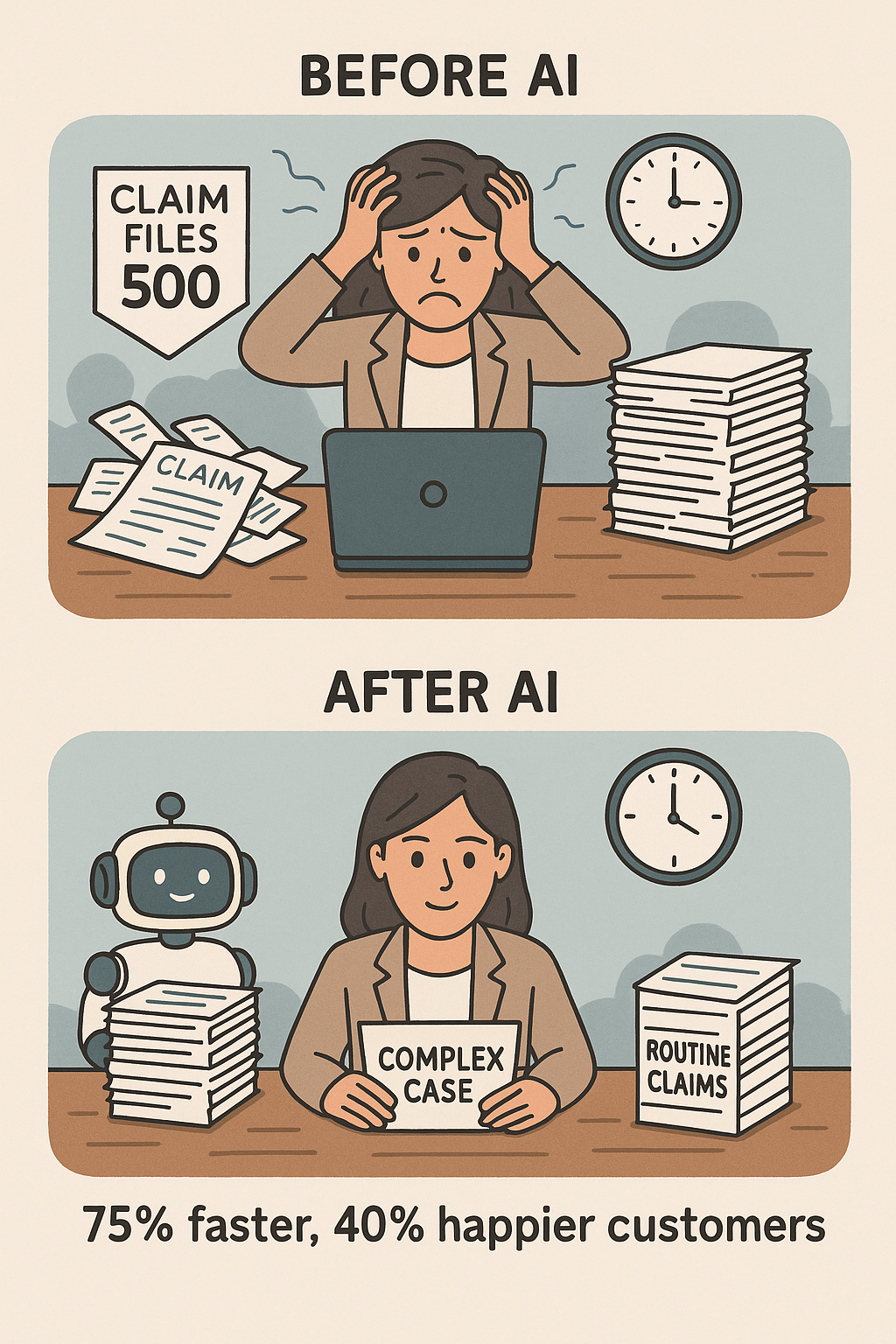
Real-World Analogies That Stick
AI models were trained to simplify text by having another AI evaluate their accuracy. Similarly, you need to test your explanations with real people.
Here are battle-tested analogies that work:
For Predictive AI: “It’s like how Netflix knows what show you’ll love next, but for [your specific use case].”
For Natural Language Processing: “Remember when you had to speak robot to Siri? Now imagine that level of improvement, but for [your application].”
For Computer Vision: “It’s like having a quality inspector with superhuman eyes who never gets tired and catches defects humans miss.”
For Recommendation Engines: “It’s like having a personal shopper who knows your style, budget, and what you bought last Tuesday.”
For AI Automation: “It’s like how Amazon can predict what you’ll order next and have it ready to ship—except for your business processes.” (Speaking of which, if you’re looking for AI books or tools, check out Amazon’s AI section for hands-on resources.)
📊 Need Help Calculating Your AI ROI?
Stop guessing about AI’s impact on your business. Our free assessment tools help you:
- Calculate exact ROI for your specific use case
- Build your AI roadmap with clear milestones
- Compare vendors to find the perfect fit
- Measure productivity gains before you invest
→ Get Your Free AI Assessment Tools
Used by 10,000+ businesses to make smarter AI decisions
Part 5: The Practical Playbook – Communication Strategies That Convert
The Progressive Disclosure Method
Don’t dump everything at once. Layer your explanation like an onion (but hopefully without the tears):
Layer 1 – The Hook (5 seconds): “We help [specific audience] solve [specific problem] using AI that [simple outcome].”
Layer 2 – The How (30 seconds): “It works by [simple analogy] to [tangible benefit].”
Layer 3 – The Proof (2 minutes): “For example, [specific client] saw [specific measurable result].”
Layer 4 – The Deep Dive (as needed): “If you’re curious about the technical details…”
To improve your communication at each layer, our Prompt Improvement Tool can help you craft clearer, more effective explanations that resonate with your audience.
The “Explain Like I’m Five” Test
The Explain Like I’m 5 Tool uses advanced AI models, such as GPT-4 and ChatGPT, to analyze the complex topic you provide. It then creates a simplified explanation using relatable examples, analogies, and straightforward language.
Before any presentation, document, or sales pitch, run it through this filter:
- Could a smart 10-year-old understand this?
- Are you using industry jargon without defining it?
- Can you draw it on a napkin?
Tools like Jasper AI and Copy.ai can help you rewrite complex technical content into simpler, more accessible language. For visual explanations, Canva offers templates specifically designed for creating easy-to-understand infographics.
Visual Aids That Actually Aid
One of the most effective ways to communicate complex AI technology to non-technical audiences is to simplify the language used in explanations.
But don’t just simplify words—use visuals that clarify rather than confuse:
- The Before/After Comparison: Show the old workflow vs. the AI-enhanced workflow
- The Time Savings Clock: Visualize hours saved per week/month/year
- The Accuracy Meter: Display error reduction in percentage terms
- The Growth Chart: Show gradual improvement over time
- The Cost-Benefit Scale: Balance investment against returns
For creating these visuals, Designs.ai offers AI-powered design tools that can automatically generate professional graphics, while HeyGen can create AI avatar videos to explain complex concepts in a friendly, approachable way.
Once you’ve created your content, ensure it reaches your audience by optimizing it with Semrush for search visibility, and use WordAi to create multiple variations of your explanations for different platforms and audiences.
Part 6: Overcoming the Top 5 Objections (With Grace and Data)
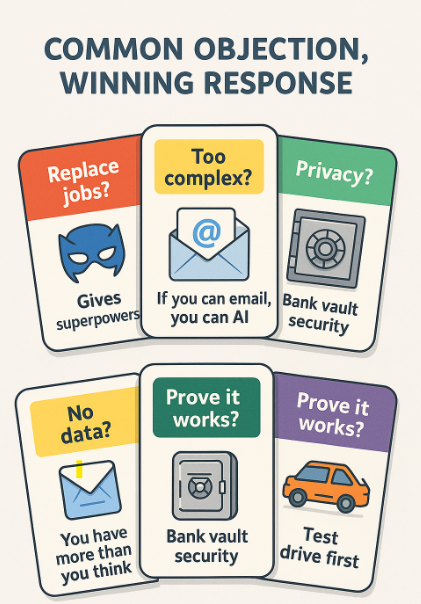
Objection 1: “Will It Replace Jobs?”
Looking at the expected effects of gen AI deployment by business function, respondents most often predict decreasing head count in service operations, such as customer care and field services, as well as in supply chain and inventory management.
Your Response: “It’s more like giving your team superpowers than replacing them. Yes, it automates routine tasks, but that frees your people to do what humans do best—build relationships, solve complex problems, and innovate.”
Objection 2: “We Don’t Have the Data”
Your Response: “You have more data than you think. Every email, every transaction, every customer interaction is data. We help you organize and use what you already have, not create something from nothing. Let me show you with our free AI Readiness Assessment exactly what data you can leverage right now.”
Objection 3: “It’s Too Complex for Our Team”
AI communication tools are no longer just nice to have, they’re reshaping how businesses function, from customer support and sales to internal collaboration and team efficiency.
Your Response: “Remember when everyone thought email was too complex? Our AI is designed to be as easy as sending a message. If your team can use Slack or Excel, they can use this. Plus, our AI Implementation Roadmap breaks everything down into simple, manageable steps.”
Objection 4: “What About Privacy and Security?”
Building customer trust is also one of the most significant challenges.
Your Response: “Privacy isn’t an afterthought—it’s our foundation. Think of it like a bank vault. Your data never leaves your control, and we can show you exactly how it’s protected at every step. Check out our AI Safety Checklist to see all the safeguards we recommend.”
Objection 5: “How Do We Know It Works?”
Only 31% of leaders anticipate being able to evaluate ROI within six months, and none report achieving it yet.
Your Response: “We start with a pilot program—low risk, measurable results. Think of it as a test drive. You’ll see real results with your actual data before making any big commitments. Use our AI ROI Calculator to project your specific returns before you invest a dollar.”
Part 7: Building Your Communication Toolkit
Your 5-Point Communication Checklist
Before any AI explanation, ask yourself:
- ✓ Is my first sentence about THEIR problem, not MY solution?
- ✓ Am I using analogies they’ll understand from their world?
- ✓ Have I shown, not just told?
- ✓ Did I address fears before features?
- ✓ Can I draw this on a whiteboard?
To ensure you’re choosing the right AI tools for your communication needs, use our AI Tool Stack Builder or explore options with our AI Tool Finder.
The Power Phrases That Work
Keep these in your back pocket:
- “It’s like [familiar thing] but for [their specific need]”
- “You know how [common frustration]? This solves that.”
- “Imagine if [aspirational scenario]. That’s what we make possible.”
- “Think of it as [simple analogy] meets [another simple concept]”
- “The best part? You don’t need to understand how it works to benefit from it—just like you don’t need to understand engines to drive a car.”
When crafting these messages, Writesonic can help generate multiple variations to test, while Grammarly Business ensures your communication is clear and professional across all channels.
Creating Your Own Metaphor Library
Build a collection of metaphors for different audiences:
For Executives:
- ROI calculators
- Competitive advantage accelerators
- Risk mitigation systems
For End Users:
- Helpful assistants
- Smart tools
- Time-saving partners
For IT Teams:
- Integration layers
- API endpoints
- Scalable infrastructure
To compare different AI solutions and find the best fit for each audience, our AI Vendor Comparison Tool helps you evaluate options side-by-side.
Pro Tip: Once you’ve perfected your AI metaphors and explanations, consider creating visual reminders for your team. Platforms like Redbubble let you turn your best analogies into posters, stickers, or even t-shirts that keep your message consistent across the organization.
Part 8: The Trust Accelerators – Advanced Strategies
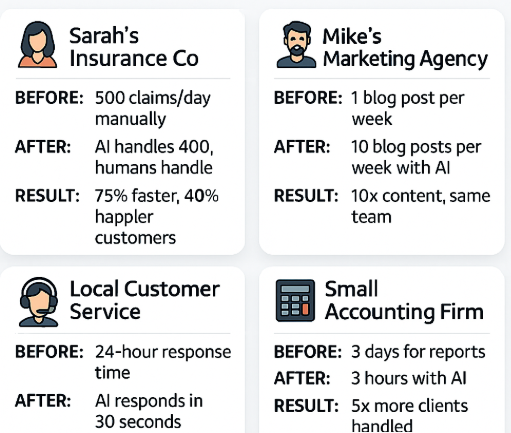
The “Try Before You Buy” Approach
Mainstream usage comes through simple, everyday tasks like emails, lists, and quick research. Adoption is broad but shallow, with no single task dominating. Light productivity and decision support lead early experimentation, showing that trust builds by addressing small, frequent needs first.
Start small to build trust:
- Offer a limited free trial with real results
- Begin with the least risky, highest value use case
- Provide white-glove onboarding support
- Celebrate small wins publicly
To measure productivity improvements during trials, our AI Productivity Assessment Tool helps quantify the real impact of AI on your workflows.
The Human Touch in AI Communication
AI is revolutionizing business communication by automating tasks, improving customer interactions, and providing valuable insights.
But remember—people buy from people:
- Share the founder’s story (why did you build this?)
- Highlight your team’s expertise (real humans behind the AI)
- Showcase customer success stories (with names and faces)
- Be available for real conversations (not just chatbots)
To establish your professional online presence, platforms like Bluehost offer reliable hosting for your AI business website, while GoDaddy can help you secure the perfect domain name. For a complete website solution with AI-focused templates, Elementor provides drag-and-drop building capabilities that don’t require coding skills.
For creating compelling founder stories and case studies, StoryLab.ai can help craft narratives that connect emotionally with your audience. To turn these stories into engaging videos, Opus Clip can automatically create short, shareable clips from longer content.
When building your email communication strategy around these stories, GetResponse or AWeber can help you nurture leads with personalized, story-driven campaigns that build trust over time.
For women leading AI initiatives, don’t miss our Women’s AI Leadership Guide which provides specific strategies for building trust and driving adoption in male-dominated tech environments.
Frequently Asked Questions (FAQs) – AEO Optimized
What is the simplest way to explain AI to someone with no technical background?
AI is like having a very specialized assistant who’s really good at finding patterns and making predictions based on what they’ve learned from lots of examples. Cassie Kozyrkov, Google’s Chief Decision Scientist, calls machine learning a fancy labeling machine. We teach the machine to label things like apples and pears by showing many examples of fruit to train on. Just like you learned to recognize dogs by seeing many different dogs, AI learns to recognize patterns by seeing many examples.
How long does it typically take to see ROI from AI implementation?
While 31% of leaders anticipate measuring ROI in six months, most recognize that productivity and operational efficiency, rather than immediate profitability, are the key returns from AI in its early stages. However, Companies expect an average ROI of almost 2x (192%) based on their experience with similar technologies. The key is starting with high-impact, low-complexity use cases.
What’s the biggest mistake companies make when explaining their AI products?
The biggest mistake is leading with technology instead of value. Without a background in technology, many stakeholders find these concepts intimidating or inaccessible. This barrier can hinder adoption and enthusiasm for innovative AI-driven solutions. Always start with the problem you solve, not how your AI works.
Should we use human-like descriptions for our AI?
Be very careful with anthropomorphization. LLMs like Claude or ChatGPT are designed to achieve quite the opposite effect: to make humans conceptualize them as individual minds with emotions, desires, beliefs, and a sense of their own self. Instead, frame your AI as a powerful tool or assistant, not a sentient being.
How do we build trust when people are skeptical about AI?
Vendors that offer observability tools, reliability controls and explainability features will emerge as near-term winners in the agentic AI market. Focus on transparency, start with small pilot programs, provide clear metrics, and always maintain human oversight for critical decisions.
What analogies work best for explaining machine learning?
For instance, you might compare a machine learning algorithm to a recipe – just as a recipe requires specific ingredients mixed in a certain way to create a dish, an algorithm needs data input in specific ways to produce results. Other effective analogies include learning to ride a bike (training through repetition), a spam filter (pattern recognition), or Netflix recommendations (personalization based on history).
How technical should our marketing materials be?
Your audience’s level of tech proficiency determines the depth of detail you should go into, and the amount of tech jargon you should use. Create layered content—simple overviews for executives, detailed specifications for IT teams, and practical benefits for end users.
Tools like Neuroflash can help you create different versions of your content optimized for different audiences, while Syllaby helps you discover what questions your specific audience is actually asking online.
What’s the most important metric to track for AI adoption?
While ROI is important, Soft ROI KPIs are less straightforward to measure against business performance in the short term, but tend to affect long-term organizational health. Track both hard metrics (time saved, cost reduced) and soft metrics (user satisfaction, employee retention, decision quality).
For comprehensive tracking and analysis, HubSpot offers robust CRM and analytics tools that can help you measure both quantitative and qualitative metrics across your AI adoption journey.
How do we handle concerns about job replacement?
Be honest but optimistic. In IT and product development, however, respondents are more likely to expect increasing than decreasing head count. Frame AI as augmenting human capabilities rather than replacing humans, and provide concrete examples of how it frees people to do more valuable work.
Consider using Kajabi or Thinkific to create training programs that help your team upskill alongside AI implementation, showing your commitment to employee development rather than replacement.
What’s the best way to demonstrate AI value quickly?
Light productivity and decision support lead early experimentation, showing that trust builds by addressing small, frequent needs first. Start with a specific, measurable problem that affects daily operations. Show before-and-after metrics within 30 days to build confidence for larger implementations.
Conclusion: Your AI Story Starts Now
Here’s the truth: The companies that win in the AI age won’t necessarily be those with the best technology. They’ll be the ones who can best explain their technology in human terms.
Companies that fail to integrate AI risk losing relevance and competitiveness. But integration isn’t just about implementation—it’s about communication, trust, and genuine understanding.
When you’re ready to share your AI story with the world, platforms like Systeme.io offer all-in-one solutions for creating landing pages that convert, while ClickFunnels can help you build complete sales funnels that guide visitors from curiosity to conversion. For those just starting out, Gumroad provides a simple way to sell AI tools and services directly to customers.
The next time someone asks you what your AI company does—whether it’s your mother, a potential customer, or a skeptical board member—you’ll be ready. Not with jargon and complexity, but with clarity, relatability, and stories that resonate.
Remember: If you can’t explain it simply, you don’t understand it well enough. And if your customers can’t understand it, they won’t buy it.
Your AI might be revolutionary, but your explanation doesn’t have to be complicated. Start with empathy, build with trust, and always—always—remember that behind every B2B decision is a human being who just wants to understand how you can make their life better.
Now go forth and explain. Your mother (and your customers) are waiting.
Resources and Tools
Free AI Assessment Tools from Chager.org
Start your AI journey with our comprehensive suite of assessment tools. Access all of these powerful resources in one place:
Get Instant Access to All Free AI Assessment Tools
Our complete toolkit includes:
- AI Readiness Assessment – Evaluate your organization’s preparedness for AI adoption
- AI Productivity Assessment Tool – Measure potential productivity gains from AI implementation
- AI Revenue Opportunity Calculator – Calculate your potential ROI from AI investments
- AI Tool Stack Builder – Design your optimal AI technology stack
- AI Implementation Roadmap Builder – Create a customized implementation plan
- AI Vendor Comparison Tool – Compare different AI solutions side-by-side
- AI Tool Finder – Discover the right AI tools for your specific needs
- Prompt Improvement Tool – Optimize your AI prompts for better results
- AI Governance Policy Template – Comprehensive policy framework for responsible AI
- Small Business AI Safety Checklist – Essential safety considerations for SMBs
- Quebec Law 25 AI Compliance Tool – For Canadian businesses navigating compliance
- Women’s AI Leadership Guide – Leadership strategies for women in AI
- Canadian SME AI Impact Funding Navigator – Find funding opportunities for Canadian businesses
Recommended AI Tools for Communication
Content Creation & Writing:
- Jasper AI – AI writing assistant for marketing content
- Copy.ai – Generate copy for ads, emails, and websites
- Writesonic – AI writer for blogs, ads, and emails
- StoryLab.ai – AI content marketing toolkit
Video & Visual Content:
- Synthesia – Create AI videos with avatars
- HeyGen – AI spokesperson videos
- Opus Clip – Turn long videos into viral shorts
- Descript – Edit video and podcasts like docs
- Designs.ai – AI-powered design suite
E-commerce & Marketplaces:
- Shopify – Build your AI product store
- Etsy – Sell AI-powered creative services
- Fiverr – Find experts to help explain your AI
- Upwork – Hire AI communication specialists
- Freelancer – Connect with technical writers
Business & Productivity:
- Grammarly Business – Writing assistant for teams
- Canva – Design platform with AI features
- Semrush – SEO and marketing insights
- HubSpot – CRM and marketing automation
Email Marketing & Automation:
- GetResponse – Email marketing and automation
- AWeber – Email marketing platform
- beehiiv – Newsletter platform for creators
Learning & Development:
- Udemy – Online learning platform
- Teachable – Create and sell online courses
- Thinkific – Course creation platform
Link & Brand Management:
- Linktree – Organize all your AI tools in one link
- Namecheap – Domain registration for your AI brand
- Sellfy – Sell digital AI products directly
Related Reading from Chager.org
Explore our latest insights on AI adoption and implementation:
- The $50K SME Automation Revolution
- Beyond the Hype: Practical AI for Canadian SMEs
- AI Governance Policy Support
- The Canadian Healthcare AI Revolution
- 170 Million New Jobs by 2030: The Upskilling Revolution
Author’s Note
This guide is based on extensive research from leading AI organizations, real-world case studies, and proven communication frameworks. The strategies presented here have been tested across various industries and audience types. Remember, the best explanation is the one that resonates with your specific audience—use these frameworks as a starting point and adapt them to your unique context.
Disclosure: Some links in this article are affiliate links, which means we may earn a commission if you make a purchase through them. This helps support our free assessment tools and resources for the AI community. We only recommend products we believe will add value to your AI journey.
Sources and Further Reading
The insights in this article are drawn from research by MIT, McKinsey, Gartner, PwC, IDC, and other leading institutions studying AI adoption and communication strategies in 2025. For specific statistics and studies referenced, please refer to the inline citations throughout the article.


Recent Comments